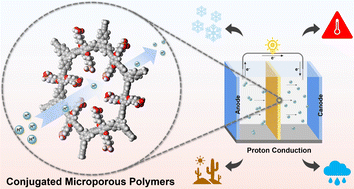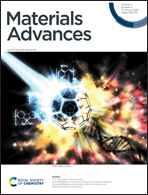Alkoxy phosphonic acid-functionalized conjugated microporous polymers for efficient and multi-environmental proton conduction†
Abstract
Proton-conducting materials are key components of proton exchange membrane fuel cells that can convert chemical fuel into electrical energy directly, efficiently, and without pollution. Despite the creation of various proton-conducting polyelectrolytes over the past decade, there is still a lack of robust electrolytes that can simultaneously satisfy high proton conductivity and multi-environmental conditions. Herein, we designed and synthesized a series of alkoxy phosphonic acid-functionalized conjugated microporous polymers (CMPs) through side-chain engineering and Sonogashira–Hagihara cross coupling. With superior stability, hydrophilic nature and high side-chain mobility, the phosphonated CMPs further serve as robust hosts to accommodate a large number of H3PO4 molecules through hydrogen-bonding, and exhibit high proton conductivity in pelletized powder samples under multi-environment conditions, such as wide temperature range anhydrous proton conductivities of 2.15 × 10−2 and 1.15 × 10−5 S cm−1 at 130 and −40 °C, respectively, and a wide humidity range proton conductivity of 1.87 × 10−2 and 9.93 × 10−2 S cm−1 at 30 °C under 32% relative humidity and 90 °C under 98% relative humidity, respectively. To the best of our knowledge, this is the first example of constructing multi-environmentally adaptable porous organic polymer proton-conducting materials for both humid and anhydrous conditions within a wide temperature range (−40 to 130 °C).



 Please wait while we load your content...
Please wait while we load your content...